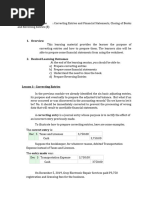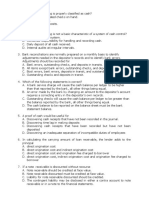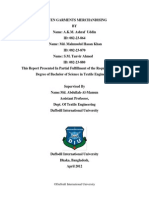Far1 Finals-Sw
Uploaded by
kireiFar1 Finals-Sw
Uploaded by
kireiFinal Term Post Seatwork no.
1 (FPOSW01)
1 Income accounts are indirectly closed to capital account.
2. Post- closing trial balance serves the same purpose as unadjusted trial balance in checking equality
of debits and credits at a given point of time.
3 All accounts are presented in post- closing trial balance.
4. Not all deferrals may not be subject to reversing entries.
5. In closing entries, drawing account is not debited.
6. In reversing entries, only those adjustments which do not increase asset or liability accounts are not
reversed.
7. After preparing a complete set of financial statements, recording and posting adjustments are still
necessary to match the information presented in worksheet.
8. In relation to an accrued expense reversed at the start of the next period, entry upon payment would
not require a debit to a liability account.
Final Term Post Seatwork no. 2 (FPOSW02)
1. Transportation in should be recognized by the seller if he/she purchases from his/her supplier not in
a FOB Destination term.
2. If seller is liable for freight cost and buyer settles it, then, it is not FOB destination and freight collect.
3. Cost of Goods Sold + Freight In + Beginning Inventory + Purchases = Ending Inventory + Purchase
Discount + Purchase Returns and Allowances
4. Perpetual Inventory system is for low cost, low value inventory type.
5. If freight term requires the seller to pay to common carrier for freight cost even though seller isn't
liable for it, then, transfer of ownership occurs when goods leave the seller's premises.
6. If the entity who pays the freight isn't the one liable in a FOB Shipping Point, then, that is not a freight
prepaid term.
7. Transportation out should be recognized by the seller if he/she sells to his/her supplier in a FOB
Destination term.
8. If the last day a customer can avail of the discount on a 2/15 term is March 3, 2019, the invoice date
is February 17, 2019.
9. Sale under perpetual inventory system would not require a debit to cost of goods sold.
10. If invoice date is June 10 and the last day of payment in net credit period is July 5, then, it is n/5
eom.
11. Cash discount allows seller to boost collection while trade discount allows seller to vary the prices
of goods without revising its price list.
Final Term Post Seatwork no. 3 (FPOSW03)
1. Applying adjusting entry method of recognizing ending inventory should not involve crediting the
ending balance in the income statement column of worksheet.
2. Recognizing ending inventory under adjusting entry method should not include a credit to ending
inventory.
3. Transferring balance of beginning inventory under closing entry method should include a credit to
expense accounts.
4. Recognizing ending inventory under adjusting entry method should include a debit to income
summary.
5. Either closing entry or adjusting entry of recognizing ending inventory would result to the same net
income / profit.
6. Applying closing entry method of recognizing ending inventory should include posting in either
debit/credit side of the income statement column of worksheet balance of income summary.
7. Conducting physical count includes counting all merchandise found in the seller's premises and
assigning the counted inventories with their specific unit cost to arrive at total cost.
8. Transferring balance of beginning inventory under closing entry method should not include a credit to
inventory, beginning.
Final Term Post Seatwork no. 3 (FPOSW04)
1. Reference of costing under FIFO periodic when it comes to ending inventory would not be from the
oldest unit cost up to the latest unit cost.
2. Function of expense consolidates first all income accounts before deducting all categories of
expenses.
3. Govt. required dues of sales employees would not be categorized in distribution cost under function
of expense method.
4. Depreciation category of expense under nature of expense includes depreciation from any PPE of
the company regardless of its function.
5. Computing ending inventory and cost of goods sold under FIFO would yield the same result either
under periodic or perpetual inventory system.
6. Other expense category would include the same expenses either under nature of expense and
function of expense.
7. Weighted average unit cost under weighted average method (periodic) is computed as the total
cost/ total units of all purchases and purchase return transactions.
8. Under moving average method of inventory cost flow, weighted average unit cost is hereby
computed whenever there is a purchase, purchase return and sales return transaction.
9. PAS 1 recommends either FIFO or Weighted Average method in applying inventory cost flow.
10. Counterpart of cost of goods sold in function of expense is increase/ decrease inventory and net
cost of purchases.
Final Term Post Seatwork no. 5 (FPOSW05)
1. Unsettled dues by the company entered through voucher system are not compiled in the paid
voucher file.
2 Cash receipts journal is applied for any transaction involving a debit to cash.
3 Cash disbursements journal is used for on involving an outflow of cash.
4 Voucher system secures that disbursement of the company's cash is duly approved by incorporating
various documents of different approvals.
5 Check register substitute cash disbursement journal.
6 Purchase journal only considers transaction involving a credit to accounts payable.
7 Subsidiary ledger is usually applied for accounts receivable and accounts payable.
8 Sales journal is used for only one transaction: a debit to accounts receivable and a credit to sales.
Answers: FPOSW04
FPOSW01 1. T
2. F
1. T
3. F
2. T
4. T
3. T
5. T
4. T
6. T
5. T
7. F
6. T
8. F
7. F
9. F
8. F
10. F
FPOSW02
FPOSW05
1. F
1. T
2. F
2. T
3. T
3. T
4. T
4. T
5. T
5. T
6. F
6. T
7. T
7. T
8. F
8. F
9. F
10. T
11. T
FPOSW03
1. T
2. T
3. T
4. F
5. T
6. F
7. F
8. F
You might also like
- M8 Correcting Closing Reversing Entries and Financial StatementsNo ratings yetM8 Correcting Closing Reversing Entries and Financial Statements10 pages
- FABM1 - Module 4 Accounting Concepts and PrinciplesNo ratings yetFABM1 - Module 4 Accounting Concepts and Principles5 pages
- Cash and Cash Equivalents Multiple Choice QuestionsNo ratings yetCash and Cash Equivalents Multiple Choice Questions13 pages
- Statement of Comprehensive Income - ExerciseNo ratings yetStatement of Comprehensive Income - Exercise2 pages
- FAR 2 Final Departmental Examination 2022No ratings yetFAR 2 Final Departmental Examination 202235 pages
- Lesson 8.1 Communication For Work Purposes Part 1No ratings yetLesson 8.1 Communication For Work Purposes Part 19 pages
- (Ust-Jpia) Quiz 1 Financial Accounting and Reporting Solution ManualNo ratings yet(Ust-Jpia) Quiz 1 Financial Accounting and Reporting Solution Manual9 pages
- FNDACT1 - H-04 - Adjusting Process Illustrative ProblemNo ratings yetFNDACT1 - H-04 - Adjusting Process Illustrative Problem6 pages
- Communications, Networks, & Cyberthreats: Presented by Satriyo AdhyNo ratings yetCommunications, Networks, & Cyberthreats: Presented by Satriyo Adhy75 pages
- Famous Filipino Artists During The Traditional Period100% (2)Famous Filipino Artists During The Traditional Period27 pages
- Part 2 - Module 7 - The Nature of Merchandising Business 1No ratings yetPart 2 - Module 7 - The Nature of Merchandising Business 113 pages
- Exercises On Hyperinflation and Cost AccountingNo ratings yetExercises On Hyperinflation and Cost Accounting4 pages
- Issues On The Philippine Biosafety Policies A CritiqueNo ratings yetIssues On The Philippine Biosafety Policies A Critique3 pages
- Filipiniana Reference and Information Sources100% (1)Filipiniana Reference and Information Sources24 pages
- FAR Receivable Financing Drills QuizzersNo ratings yetFAR Receivable Financing Drills Quizzers25 pages
- Lesson 21 - Closing Entries, Post-Closing, Trial Balance and Reversing EntriesNo ratings yetLesson 21 - Closing Entries, Post-Closing, Trial Balance and Reversing Entries8 pages
- 11 Accounting For Merchandising Businesses Part 1100% (1)11 Accounting For Merchandising Businesses Part 115 pages
- Quiz #2 - BSA 23 Absorp Variable CostingNo ratings yetQuiz #2 - BSA 23 Absorp Variable Costing6 pages
- BA 101 Case Analysis 4 (Swiss Guard) FinalNo ratings yetBA 101 Case Analysis 4 (Swiss Guard) Final6 pages
- RM - Basic Features of FS and Statement of Comprehensive IncomeNo ratings yetRM - Basic Features of FS and Statement of Comprehensive Income5 pages
- Business Transactions and Worksheet (Froilan Labausa)No ratings yetBusiness Transactions and Worksheet (Froilan Labausa)1 page
- Merchandising Accounting (Erlinda See Chua)No ratings yetMerchandising Accounting (Erlinda See Chua)1 page
- CA5101 CHAPTER 1 - EXERCISE 2 (With Key)No ratings yetCA5101 CHAPTER 1 - EXERCISE 2 (With Key)8 pages
- 2007 BP Gtcs V 2015 BP P GTCS: A Quick Re Eference E GuideNo ratings yet2007 BP Gtcs V 2015 BP P GTCS: A Quick Re Eference E Guide6 pages
- Quotation & Specification: Ruian Ruifeng Packing Machine Co.,LtdNo ratings yetQuotation & Specification: Ruian Ruifeng Packing Machine Co.,Ltd8 pages
- International Business Transactions - Karamanian - Spring 2008100% (3)International Business Transactions - Karamanian - Spring 200833 pages
- International Trade: Import-Export ProcedureNo ratings yetInternational Trade: Import-Export Procedure5 pages
- Financial Accounting 11th Edition Harrison Test Bank100% (25)Financial Accounting 11th Edition Harrison Test Bank39 pages
- IAS 21 Notes and class examples_2024_1 per pageNo ratings yetIAS 21 Notes and class examples_2024_1 per page39 pages
- Ocean Atlantic Co Is A Merchandising Business The Account BalaNo ratings yetOcean Atlantic Co Is A Merchandising Business The Account Bala2 pages

























































































